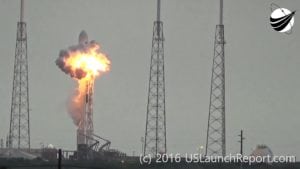SpaceX Completes Anomaly Investigation, Announces Jan. 8 Return to Flight

Video screen shot from SpaceX’s Falcon 9 explosion on Sept. 1, 2016 with the Amos 6 satellite on board. Photo: USLaunchReport
[Via Satellite 01-05-2016] SpaceX is targeting return to flight from Vandenberg’s Space Launch Complex 4E (SLC-4E) with the Iridium NEXT launch on January 8. Over the past four months, officials at the Federal Aviation Administration (FAA), the U.S. Air Force (USAF), NASA, the National Transportation Safety Board (NTSB) and industry experts, have collaborated with SpaceX to determine the cause of the anomaly that occurred Sept. 1, 2016 at Space Launch Complex 40 (SLC-40) at Cape Canaveral Air Force Station in Florida.
The accident investigation team worked systematically through an extensive fault tree analysis and concluded that one of the three Composite Overwrapped Pressure Vessels (COPVs) inside the second stage Liquid Oxygen (LOX) tank failed. Specifically, the investigation team concluded the failure was likely due to the accumulation of oxygen between the COPV liner and overwrap in a void or a buckle in the liner, leading to ignition and the subsequent failure of the COPV, SpaceX reported in a statement.
Each stage of Falcon 9 uses COPVs to store cold helium which is used to maintain tank pressure, and each COPV consists of an aluminum inner liner with a carbon overwrap. The recovered COPVs showed buckles in their liners. Although buckles were not shown to burst a COPV on their own, investigators concluded that super chilled LOX can pool in these buckles under the overwrap. When pressurized, oxygen pooled in this buckle can become trapped; in turn, breaking fibers or friction can ignite the oxygen in the overwrap, causing the COPV to fail. In addition, investigators determined that the loading temperature of the helium was cold enough to create solid oxygen (SOX), which exacerbates the possibility of oxygen becoming trapped as well as the likelihood of friction ignition.
The investigation team identified several credible causes for the COPV failure, all of which involve accumulation of super chilled LOX or SOX in buckles under the overwrap. According to a statement by SpaceX, the corrective actions address all credible causes and focus on changes, which avoid the conditions that led to these credible causes. In the short term, this entails changing the COPV configuration to allow warmer temperature helium to be loaded, as well as returning helium loading operations to a prior flight proven configuration based on operations used in over 700 successful COPV loads. In the long term, SpaceX will implement design changes to the COPVs to prevent buckles altogether, which aim to allow for faster loading operations.